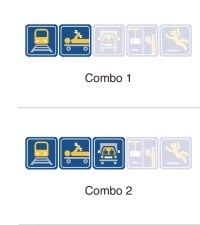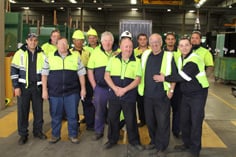
Last week, we looked at three different arguments to convince senior management about why they need to care about safety.
 Mistakes are a healthy part of learning. They're nothing to be embarrassed about, as long as you learn from them and move on. But being sloppy is a totally different story.
Mistakes are a healthy part of learning. They're nothing to be embarrassed about, as long as you learn from them and move on. But being sloppy is a totally different story.
What makes the following workplace communication mistakes particularly sloppy is that they provide enormous returns if you get them right and just make a mockery of your whole workplace safety communication strategy (you do have one, don't you?) when they are done incorrectly.
So stop being sloppy, and make sure you're not making any of these common workplace safety communication errors:
1. Showing photos of people doing stuff the wrong way - Due to the funny way our mind works, people remember what we see. So if you show someone lifting a box the wrong way, guess what you're teaching them? Show people the right way. Putting big red marks across a poor lift is just lazy communication. Showing people what not to do, doesn't help them with what to do. Help people understand what they are meant to do, by showing them what to do.
2. Writing wordy training manuals - Do you really think anyone wants to read through 11 pages of your rules about isolations when it reads like it's been written by a lawyer? Avoid getting committees to write regulations for procedures and then believe that's good enough for training. It just smacks of a company wanting to protect itself, rather than provide advice on how to say, do an isolation correctly. Use clear English, explain with photos or videos liberally and give people steps on how to do things that can be read out to a child. You know you've got a well written training manual when an eight year old child can read it (and understand).
 3. Making it hard for people to understand what hazard or process they are reading about - If you still need to have pages and pages of text for people to read, make it easier for them to know instantly what hazard or process the document is discussing. Use graphic representations for each hazard or process that is custom designed for your company, so that it makes sense in your environment. Have that graphical representaiton at the top of the page. You can then use these icons for other safety communication pieces such as posters, so that people can instantly recognise the hazard and pay attention. Read more at How to Easily Identify Hazards or Injuries in your Workplace Documents.
3. Making it hard for people to understand what hazard or process they are reading about - If you still need to have pages and pages of text for people to read, make it easier for them to know instantly what hazard or process the document is discussing. Use graphic representations for each hazard or process that is custom designed for your company, so that it makes sense in your environment. Have that graphical representaiton at the top of the page. You can then use these icons for other safety communication pieces such as posters, so that people can instantly recognise the hazard and pay attention. Read more at How to Easily Identify Hazards or Injuries in your Workplace Documents.
4. Using boring photos or videos of equipment - People love looking at other people. Have you ever taken holiday photos of a beautiful landscape, only to find the beautiful landscape looks better with someone in it? When taking photos or videos of your equipment or processes, ensure staff are featured. And try and show their face. It's also much more effective to include photos in your posters that have a face. Avoid plain text and a drawing.
 5. Using negative language - Sometimes it seems logical that the only way to get people to change is to tell them off. But it just comes across as nagging and gets ignored. Avoid writing any safety communication with "Don't go up a ladder on your own" or "No horse play" (my favourite, because who knew horses liked to play at work? It actually makes me want to run around neighing like a mad horse). This brings me to my second point that using negative language can entice people to want to make fun of it, rather than pay attention. Instead, tell people what you want using positive language and be friendly about it. For example, rather than say "Don't PANIC" say "Stay CALM". Using negative language, is similar to showing photos of incorrect behavour. By telling (and showing) people the behaviour you want they are more likely to understand and remember. Technically, this means that if your want horse play at the workplace, you can run around like a mad horse as an example.
5. Using negative language - Sometimes it seems logical that the only way to get people to change is to tell them off. But it just comes across as nagging and gets ignored. Avoid writing any safety communication with "Don't go up a ladder on your own" or "No horse play" (my favourite, because who knew horses liked to play at work? It actually makes me want to run around neighing like a mad horse). This brings me to my second point that using negative language can entice people to want to make fun of it, rather than pay attention. Instead, tell people what you want using positive language and be friendly about it. For example, rather than say "Don't PANIC" say "Stay CALM". Using negative language, is similar to showing photos of incorrect behavour. By telling (and showing) people the behaviour you want they are more likely to understand and remember. Technically, this means that if your want horse play at the workplace, you can run around like a mad horse as an example.
If you're making any of these workplace safety communication mistakes, shhh...we won't tell anyone...as long as you promise to go fix it. These are easy mistakes to make, but luckily, they are also fairly easy to remedy. And whether you have a fledgling workplace safety communication strategy or a robust one, fixing these mistakes is a guaranteed way to start getting the attention of staff and contractors.
Photo Credit: Flickr, opensourceway (mistakes) and Squeezyboy (horseplay)

Last week, we looked at three different arguments to convince senior management about why they need to care about safety.

For some companies, toolbox meetings can be a real drag with disinterested staff and the safety manager trying desperately to motivate staff and change behaviour.